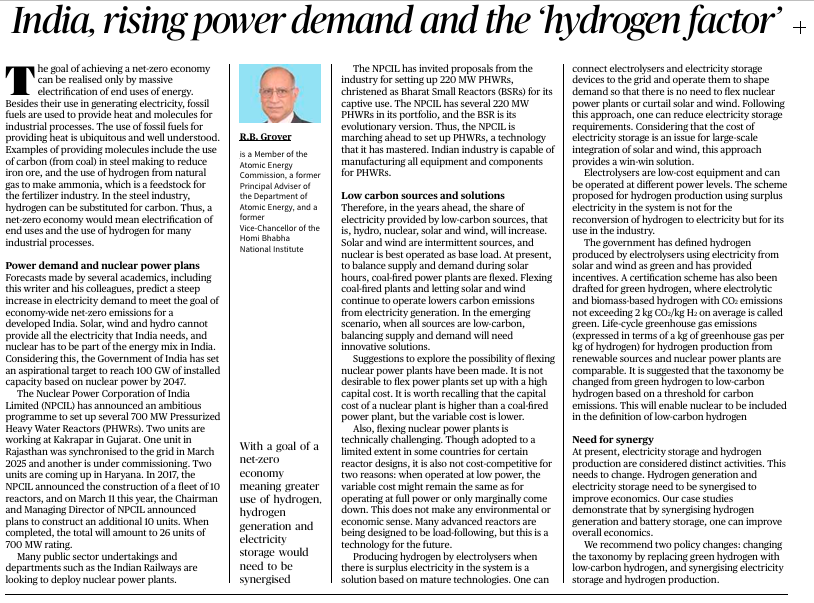GS Paper III – Energy, Environment, Science & Technology
10-Marker (150 words):
🔹 “Hydrogen can play a crucial role in decarbonizing India’s industrial sector.” Examine the potential and challenges of hydrogen energy in India’s path to net-zero emissions.
Introduction & Context
- Goal of Net-Zero Economy:
- Achieving net-zero emissions requires massive electrification of end uses and industries.
- Fossil fuels are widely used in energy and industrial processes like steel and fertilizer production.
- For decarbonization, hydrogen can replace carbon-based fuels in industries.
- Achieving net-zero emissions requires massive electrification of end uses and industries.
- Hydrogen’s Role:
- Steel: Hydrogen replaces coal to reduce iron ore.
- Fertilizer: Hydrogen from natural gas to make ammonia can be replaced by green hydrogen.
- Steel: Hydrogen replaces coal to reduce iron ore.
II. Rising Power Demand & Role of Nuclear Energy
- Growing Power Demand:
- Studies predict a steep rise in electricity demand to meet net-zero targets.
- Solar, wind, and hydro can’t meet total demand — nuclear energy must play a role.
- Studies predict a steep rise in electricity demand to meet net-zero targets.
- India’s Nuclear Power Targets:
- Government aims to reach 100 GW of nuclear power capacity by 2047.
- NPCIL has announced/initiated several new Pressurized Heavy Water Reactors (PHWRs).
- Units in Gujarat and Rajasthan; fleet of 10 reactors under planning.
- Target of 700 MW per unit.
- Units in Gujarat and Rajasthan; fleet of 10 reactors under planning.
- Government aims to reach 100 GW of nuclear power capacity by 2047.
- Private Sector Involvement:
- Public Sector Undertakings and private industries exploring nuclear development.
- Public Sector Undertakings and private industries exploring nuclear development.
III. Low-Carbon Energy Sources: Future Share & Strategy
- Diversified Low-Carbon Energy Mix:
- Future energy mix: Hydro, nuclear, solar, wind — all will increase.
- Nuclear plays base load role; solar/wind are intermittent.
- Future energy mix: Hydro, nuclear, solar, wind — all will increase.
- Flexing Role of Fossil Fuels:
- Currently used to balance demand-supply mismatches.
- Flexibility in fossil-based plants may be replaced by large-scale electricity storage and electrolyzers.
- Currently used to balance demand-supply mismatches.
IV. Electrolyzers & Hydrogen Production
- Electrolyzers in Energy Grid:
- Convert electricity to hydrogen during off-peak times.
- Avoids need to build new nuclear or fossil plants for intermittent supply.
- Can be part of large-scale energy storage
- Convert electricity to hydrogen during off-peak times.
- Policy for Electrolyzers:
- Should support hydrogen generation, not reconversion into electricity.
- Hydrogen from electrolysis (solar/wind) is green; classification and certification schemes
- Should support hydrogen generation, not reconversion into electricity.
V. Green Hydrogen Certification & Standards
- Classification and Incentives:
- Hydrogen produced from solar/wind via electrolysis = green hydrogen.
- Electrolytic and biomass-based hydrogen certified as green if CO₂ < 2 kg/kg H₂.
- Suggestion: Include nuclear-based hydrogen under low-carbon hydrogen
VI. Integration of Hydrogen & Electricity Sectors
- Need for Sector Synergy:
- Hydrogen and electricity sectors currently treated separately.
- Both must be synergized for economic and climate benefits.
- Hydrogen from electricity (electrolyzers) + electricity storage = dual benefits.
- Mutual Benefit & Grid Stability:
- Hydrogen production helps manage electricity oversupply.
- Reduces the need for fossil fuel-based flexing plants.
VII. Conclusion & Policy Recommendations
- Policy Focus:
- Encourage integrated planning of hydrogen production and electricity grid.
- Include nuclear-based hydrogen in low-carbon definition.
- Consider electrolyzers and storage devices as grid assets to ensure reliability.


